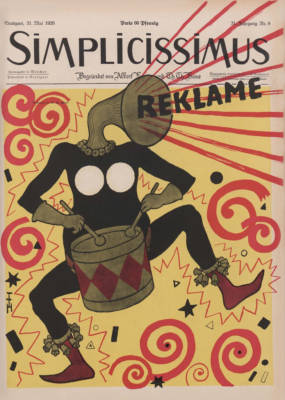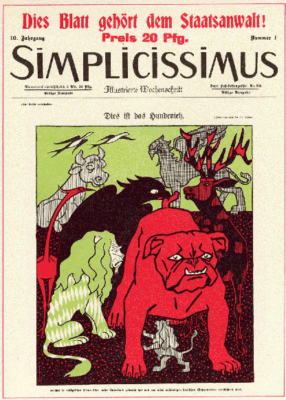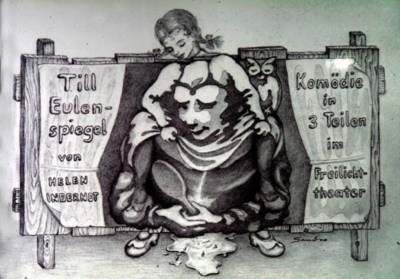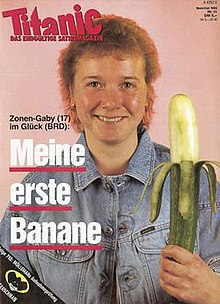Taking a look at Germany’s satire and humor magazines.
You don’t go to Germany for the humor. Most wouldn’t expect to find it there.
But there is. Surprisingly lots of it. And good stuff at that.
 For instance, take a look at their satire/humor magazines: Titanic and Eulenspiegel. A nation of 82 million has two major humor periodicals which equals America’s output in its humor heyday of the 1970’s with the eternal MAD Magazine (although it is going under and will be printing its last few magazine shortly) and the long defunct and largely forgotten National Lampoon in a nation of 325 million (damn, the Germans got us beat at our own game!). Even the Czech Republic with only 10 million people has several satire publications. Of course they themselves are famous as a people with sharp wits (just ask the Russians who tried to control them for 40 years!).
For instance, take a look at their satire/humor magazines: Titanic and Eulenspiegel. A nation of 82 million has two major humor periodicals which equals America’s output in its humor heyday of the 1970’s with the eternal MAD Magazine (although it is going under and will be printing its last few magazine shortly) and the long defunct and largely forgotten National Lampoon in a nation of 325 million (damn, the Germans got us beat at our own game!). Even the Czech Republic with only 10 million people has several satire publications. Of course they themselves are famous as a people with sharp wits (just ask the Russians who tried to control them for 40 years!).
The original big time satire magazine in Germany was the excellent Simplicissimus, published in the Schwabing area of Munich;which was the Greenwich Village of Germany in the 1800’s. With razor sharp wit and excellent drawings they skewered the politicians and public figures of their times with a certain type of expertise as seen yet not seen in our country (sorry Jon Stewart!). They lasted until the second World War when Hitlers minions successfully stole the humor and strong armed them into being a mouthpiece for the Nazi cause. Unfortunately Hitler’s war was also the death knell of many of the smaller Germanic humor magazines that had been around since the 1800’s. Simplicissimus was revived for a time in a lesser energetic form from 1954 to 1967.
 The devastation of the war ruined a lot of the humorists and humor periodicals, but, like the phoenix bird, from the ashes rose a new beginning via a Zeitschrift in Berlin called Ulenspiegel. The destruction and horror of the war made many realize the need for lightness and laughter that was pretty much forbidden in the Third Reich era. It too had the fine graphic design and sharp humor that had made Simplicissimus famous. Emphasizing the new found freedom and democracy that many Germans had been starved for, the publication ran strangely afoul of the American military authorities overseeing that part of occupied Berlin. Seeking their own freedom Ulenspiegel moved over to the Soviet sector where it wasn’t long before the communists cracked down on them even though they were considered left wing. Finally in the 1950’s they had their license to publish pulled; a common tactic in Soviet and East German areas for getting rid of artists who did not toe the official line.
The devastation of the war ruined a lot of the humorists and humor periodicals, but, like the phoenix bird, from the ashes rose a new beginning via a Zeitschrift in Berlin called Ulenspiegel. The destruction and horror of the war made many realize the need for lightness and laughter that was pretty much forbidden in the Third Reich era. It too had the fine graphic design and sharp humor that had made Simplicissimus famous. Emphasizing the new found freedom and democracy that many Germans had been starved for, the publication ran strangely afoul of the American military authorities overseeing that part of occupied Berlin. Seeking their own freedom Ulenspiegel moved over to the Soviet sector where it wasn’t long before the communists cracked down on them even though they were considered left wing. Finally in the 1950’s they had their license to publish pulled; a common tactic in Soviet and East German areas for getting rid of artists who did not toe the official line.
But the phoenix reincarnated again. A new publication — Eulenspiegel (similar in name but founded by different people than Ulenspiegel) started life as a mild satirical and humor publication that had to stay sharply within the narrow confines allowed by the East German regime. Anything published could only be low level criticism of non governmental institutions, mores or social situations. It was for the duration of the East German Republic the only satire magazine there was. Yet it sold up to 500,000(!) copies with every printing, pretty good for a nation of only about 18,000 million. That doesn’t mean it was all roses. Even with their limited criticism of the powers that be they still rankled the political machine who tried to limit their production.
 As time went on, Eulenspiegel, the name slyly referring both to a famous fairy tale character who pulled scatological jokes on people, but was a hero to the oppressed and to an underground meaning of ‘cleaning your behind’ (it’s up to you to decide which), slowly evolved a more deft humor. When the Berlin wall fell it took off like a shot and became full force subversive and hilarious. Dark humor crept in and they soon became the experts at it. Their laughs are quite similar to that of Mad magazine, but not quite as juvenile, and to National Lampoon, though without the crassness and blatant sexuality that the Lampoon was noted for.
As time went on, Eulenspiegel, the name slyly referring both to a famous fairy tale character who pulled scatological jokes on people, but was a hero to the oppressed and to an underground meaning of ‘cleaning your behind’ (it’s up to you to decide which), slowly evolved a more deft humor. When the Berlin wall fell it took off like a shot and became full force subversive and hilarious. Dark humor crept in and they soon became the experts at it. Their laughs are quite similar to that of Mad magazine, but not quite as juvenile, and to National Lampoon, though without the crassness and blatant sexuality that the Lampoon was noted for.
Politically, Eulenspiegel can beat anything the US puts out. Plus they pull in little known but talented writers and artists from the former Soviet Bloc lands of Romania, Poland,Czech Republic etcetera. One does have to hand it to a publication and its creators that can survive as unfunny and repressive a regime as the Deutche Demokratic Republic was. It was prophesied by many that after the reunion with West Germany that Eulenspiegel would suffer the fate of many East German businesses and be trod under by the wealthier and more sophisticated Capitalists. Wrong! It is now going strong as an institution representing the humor of both East and West; one of only three DDR publication to survive the change.

Eulenspiegel’s long entrenched West German rival in the funny business industry is Titanic, a similar periodical that has been around since 1979 created by dissatisfied rebels from ‘pardon’, another satire magazine (the capital-less ‘p’ was their take on the name). While not as caustic as Eulenspiegel, Titanic has had its share of notoriety. When there was a vote going on for where to play the 2006 FIFA World Cup local, the publisher sent hoax faxes to delegates offering bribes to have it in Germany. Here is a copy of one of them presented by Wikipedia:
In this difficult situation, Germany would like to emphasize the urgency of its appeal to hold the World Cup 2006 in Germany.
Let me come straight to the point: In appreciation of your support we would like to offer you a small gift for your vote in favor of Germany: A fine basket with specialties from the black forest, including some really good sausages, ham and — hold on to your seat — a wonderful KuKuClock!
And a beer mug, too! Do we leave you any choice?
We trust in the wisdom of your decision tomorrow,
sincerely yours,
Martin Sonneborn
Secretary TDES
(WM 2006 initiative)
— Original text of the fax, sent by Titanic on July 5th, 2000
Strangely, a National Enquirer type tabloid called Bild that specialized in fake news took the bribe to be real news and put out a ad in its newspaper for readers to call Titanic and complain about the damage this did to Germany’s reputation. Not missing a chance, the writer’s and editors of Titanic collected the funniest of the calls they got and published them on a CD for their fans.
The magazine’s favorite target was former Chancellor Helmut Kohl for whom Titanic dubbed ‘the pear’ because his head had that shape. It stuck. He appeared on their cover more times than any other national figure (imagine what they would have done with Trump as Chancellor. God Forbid!)
Author’s credits: Material for this article was gleaned from my own experiences living and writing in Germany, from issues of Titanic, Simplicissimus and Eulenspiegel, from German museums, from a letter stating the history of Eulenspiegel sent by its Redaktur and from Wikipedia articles on German Humor, German Humor Magazines and on East Germany.
- In Lieu of Coin Shortage, US Hurriedly Mints Special Commemorative Coins That Don’t Go Over So Well - August 3, 2020
- Memes Both Trump and McNaughton Deserve - July 29, 2020
- Random Drive-by Memes - June 12, 2020

